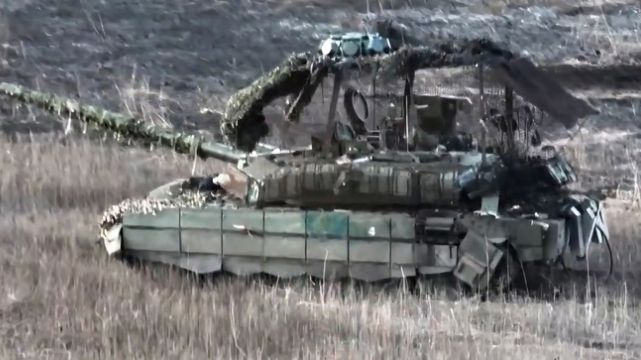FPV Drones Pose Increasing Threat, Russia Equips Tanks with EW Systems
In response to the escalating threat posed by First Person View (FPV) drones, the Russian military has equipped its tanks, including the T-72 and T-90 models, with electronic warfare (EW) systems to counteract these drone attacks.
(DEFENCE SECURITY ASIA) — In the ongoing conflict between Russia and Ukraine, the role of small First Person View (FPV) drones equipped with explosives has become increasingly critical as a tool for targeting defensive positions and other military assets, including armored personnel carriers and tanks.
In response to the growing threat posed by FPV drones, the Russian military has upgraded their tanks, including the T-72 and T-90 models, with electronic warfare (EW) systems to counter these drone attacks.
Recent reports from Russian telegram channels closely associated with its military have revealed images demonstrating how the T-72 tanks have undergone significant modifications to be fitted with EW systems.
These tanks are not only equipped with “cage armor” to protect against FPV drone attacks but also feature various antennas and equipment indicating the integration of sophisticated EW systems.
These tanks, now equipped with integrated EW systems, have not only been tested by Russian defense experts but have also been deployed to the battlefield to confront actual threats.

.
In addition to the T-72, the T-90 Russian tanks have also been reported to be fitted with integrated EW systems.
While the specific types of EW systems used by the T-72 and T-90 tanks remain unclear, Russian military observers suggest that the design of these systems is similar to the “Triton” EW System tested by the country last year.
If indeed these are “Triton” systems, the successful tests conducted last year appear to have paved the way for their deployment in real combat situations.
According to Russian military watchers, the “Triton” EW System uses four emitters placed at each corner of the tank to protect it from FPV drone attacks from any direction by jamming the main frequencies used by the FPV operators.
In addition to the “Triton” system, Russian military assets are also known to employ the “Volnorez” EW System to protect against the increasingly utilized FPV drones by both Russian and Ukrainian forces, as well as kamikaze drones.


Similar to the “Triton”, the “Volnorez” system disrupts the frequencies emitted by FPV drone controllers, causing a loss of signal and preventing the drones from targeting the tanks.
The explosives carried by FPV drones have become more powerful, capable of striking and destroying main battle tanks like the T-72 and T-90, prompting Russia to equip its armored vehicles with specialized EW systems to counter the FPV drone threat.
Currently, most FPV drones used by both Ukraine and Russia employ PG-7V projectiles, typically used in Rocket Propelled Grenades (RPGs), as their explosive material to target the upper parts of tanks and armored vehicles. — DSA


